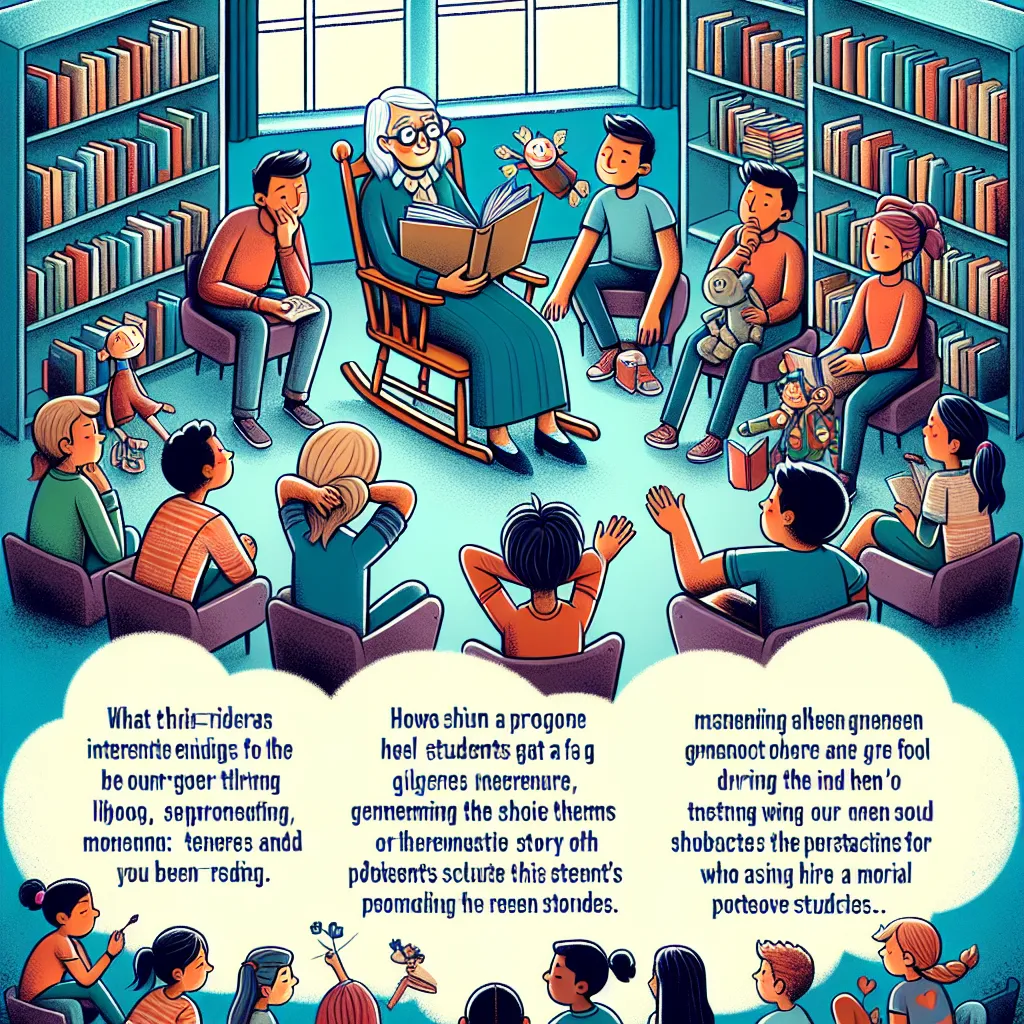Ask AI on The Internet
Question: 1.1 Explain how you as the teacher would encourage the learners in your class to actively participate in sharing library activities to foster a positive reading culture. Please provide TWO (2) specific examples of interactive activities. (4) 1.2 In your own words, describe a memorable reading-time experience from your childhood. What strategies were used to make the reading session special and how did it impact your ongoing engagement with books until adulthood? (3) 1.3 Describe a scenario in which you would engage the learners' imagination to create alternative endings for a story during a whole class-shared reading lesson. How will this activity promote creativity and critical thinking in the learners? (5) 1.4 Share an example of your favourite book or story. Imagine that you are reading this story to a learner and encourage them to become the main character. Critically discuss how this personalised approach will enhance the learners' enthusiasm for storytelling and reading. (3) 1.5 Create a moral dilemma or moral of the story that you would introduce during a reading session with your learners in the classroom. How will you facilitate a thoughtful discussion around the dilemma or moral, and what lessons or values do you want the learners to take away from the experience regarding building a positive reading culture?
**1.1 Encouraging Learners to Participate in Library Activities** To encourage learners to actively participate in library activities and foster a positive reading culture, I would use interactive activities such as: **Activity 1: Book Club Meetings** - Arrange periodic book club meetings where learners can choose a book to read and discuss as a group. - Encourage them to express their thoughts, highlight their favorite passages, and even create visual art or summaries related to the book. This will engage their analytical and creative skills, making reading a group and interactive endeavor. **Activity 2: Library Scavenger Hunt** - Organize a scavenger hunt in the library where learners need to find books based on specific clues related to their covers, genres, or authors. - This activity would make library visits fun and educational, helping students to explore different sections of the library and discover new books. **1.2 Memorable Reading-Time Experience** One memorable reading-time experience from my childhood was when my third-grade teacher held a "Reading Under the Stars" event. We turned off the classroom lights, and each student had a small flashlight. We set up blankets and pillows on the floor, creating a cozy, magical atmosphere. The teacher read a captivating story, and we followed along in our books. The special atmosphere made reading feel like an adventure. The strategy of creating an immersive and comfortable environment significantly impacted my engagement with books, instilling a love for reading that continued into adulthood. **1.3 Engaging Learners in Creating Alternative Endings** Imagine a scenario where I read a classic story like "Little Red Riding Hood" to the class. After finishing the story, I would invite the learners to imagine and write or share their own alternative endings. For example, some students might write an ending where Little Red outsmarts the wolf using a clever trick, while others might imagine a scenario where the wolf is reformed and apologizes for his behavior. This activity promotes creativity by encouraging students to think beyond the given narrative and invent their unique conclusions. It also fosters critical thinking as they have to ensure their alternative endings are plausible within the story's context and logical narrative flow. **1.4 Personalized Storytelling Approach** My favorite book is "Charlotte's Web" by E.B. White. While reading this story to a learner, I would encourage them to imagine themselves as Wilbur, the pig. I would ask them how they would feel in Wilbur's situation, what they would do differently, and what their thoughts are about the other characters like Charlotte and Fern. This personalized approach aids in: - Enhancing the learner's enthusiasm by making the story more relatable. - Encouraging empathy and understanding of the characters' emotions and motivations. - Making storytelling interactive and dynamic, thus deepening the learner's engagement with the narrative. **1.5 Introducing a Moral Dilemma** Let's consider a reading session involving the story "The Boy Who Cried Wolf." The moral dilemma presented is about honesty and the consequences of lying. After reading the story, I would facilitate a discussion around questions like: - Why did the boy choose to lie? - What were the consequences of his dishonesty? - How might things have been different if he had told the truth? I would guide the learners to share their views and weave in lessons about the importance of honesty, trustworthiness, and the impact our actions can have on others. By discussing these values, students will learn the importance of integrity and the consequences of their actions. This thoughtful discussion helps build a positive reading culture where students see stories as opportunities for personal growth and moral learning.
Think your answer is better than the AI's? Post it below.
Other Most Relevant Posts:
Question Tags
If you want your question answered by an AI, click here.







Post your own comment: